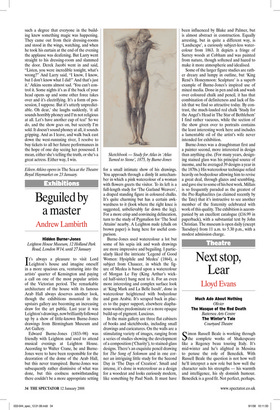Next stop, Lear
Lloyd Evans
Much Ado About Nothing Olivier The Masque of the Red Death Battersea Arts Centre The Winter’s Tale Courtyard Theatre
Simon Russell Beale is working through the complete works of Shakespeare like a Regency beau touring Italy. It’s mid-winter and he’s alighted in Messina to peruse the role of Benedick. With Russell Beale the question is not how well he’ll interpret a new role but how well the character suits his strengths — his warmth and intelligence, his sly donnish humour. Benedick is a good fit. Not perfect, perhaps. The dash and romantic energy aren’t quite there because Russell Beale is, shall we say, a little more settled in his ways than the part requires. But he has such an effortless stage presence that even this portly grey-bearded Benedick erases earlier performances from the mind. Next stop, Lear. As Beatrice, Zoë Wanamaker is even more unexpected, a grave, bookish, alienated, cocktail-swigging creature who eventually drops the sauce and chooses marriage instead. Unexpectedly moving. Aside from Wanamaker’s tragic notes, this is a broad and often hilarious production which makes the most of the play’s farcical possibilities and includes a hidden swimming-pool which both leads employ to brilliant effect. The ‘comic’ parts of Dogberry and Verges are taken by Mark Addy (the plumpest stripper from The Full Monty) and Trevor Peacock (the stammering twit from Dibley), and I’m glad to say that these two heroic performers succeed in discovering genuine comedy in a pair of roles which, even by Shakespeare’s standards, are about as funny as a fish with hiccups.
Battersea Arts Centre has been taken over by The Masque of the Red Death, a sprawling mass of theatrical inventiveness based on a short story by Edgar Allen Poe. On arrival you’re given a huge Venetian carnival mask and told to explore the building in disguise. Off I trooped. Amid darkened corridors and draped alcoves I found an apothecary’s shop, a candlelit dinner party minus the guests, a staircase dressed up as a forest, a tousled four-poster, a ghostly boudoir with a hysterical soprano singing a Puccini aria to a skeleton, and a vestry sentried by silent men in capes worldlessly dressing other silent men in capes. There were actors flouncing about here and there, and the lack of dramatic purpose was offset by some fine visual effects and a certain dogged integrity. My mask fitted badly and when I pulled it off I was instantly approached by a junior luvvie dressed as Batman. ‘Mask back on,’ he said in a bossy whisper. ‘I’d love to,’ I said amiably, ‘but it smells of vomit.’ That was all the dialogue I heard for the first halfhour. Opening an unmarked door I found myself at the back of an auditorium where a music-hall act was in progress, complete with a mind-reader and can-can dancers. Elsewhere, bits of a drama were being played out but they were hard to locate within the cranny-ridden building. Mighty confusing. It’s possible I misunderstood — and missed — large parts of this show but I was left with the impression of a bold and gloomily dazzling spectacle with one overriding aim: to flout convention at any price, even intelligibility. Without doubt this is the weirdest piece of theatre I’ve ever seen but ultimately its wackiness is rather monochrome. Then again, if you relish Gothic high camp — or if you’re a depressed teenager plotting to murder your parents and firebomb your school — you’ll find lots here to feed your imagination.
Phil Willmott’s The Winter’s Tale is worth seeing if only for the excellence of its vandalism. Willmott has chopped up the script so that the play opens with Autolycus and his chortling bumpkins and shows Leontes’s jealousy as a lengthy flashback. This at last resolves one of the play’s key problems, the disjunction in mood between the first and second halves. The other main problem, that Leontes’s suspicions of Hermione appear groundless, can be resolved only if Hermione is played as a mischievous vamp who flirts with Polixenes in order to provoke and anger Leontes whom she loathes. (‘What! Have I twice said well? When was’t before? I prythee, tell me’ is brimming with ironic resentment.) Not much of this is detectable in Natasha Seale’s highly watchable performance which takes the conventional view of Hermione as Doris Day rather than Marilyn Monroe. Matthew Ward gives Camillo exactly the right sense of broody nobility and Phil Sealey’s enjoyable Autolycus is a plump red-haired Victorian jester with a top hat and a beard you could stuff a sofa with. A fine and entertaining version of this off-kilter play. Willmott’s script reformations should be adopted universally.



























































 Previous page
Previous page